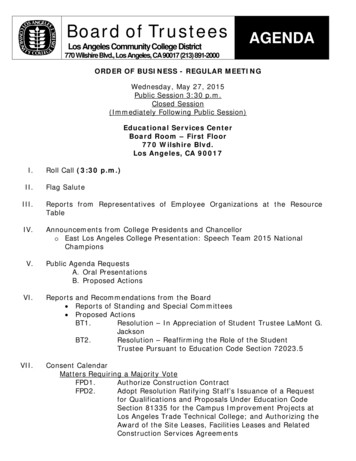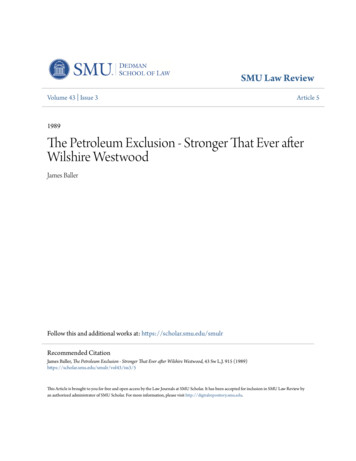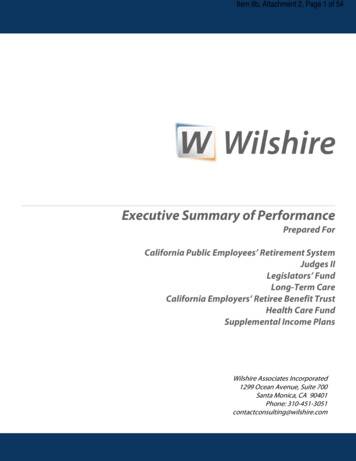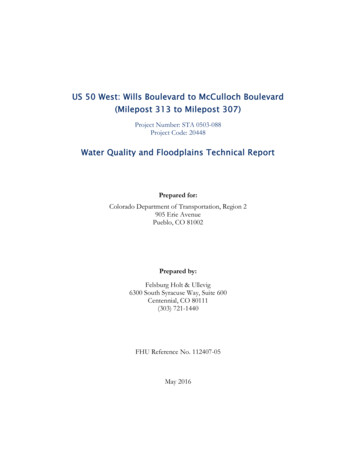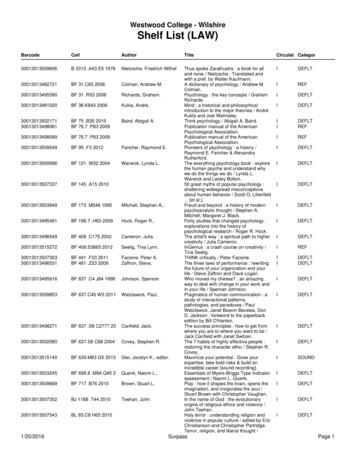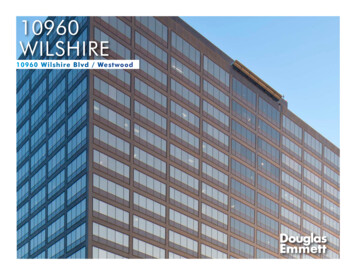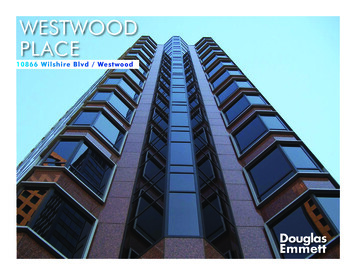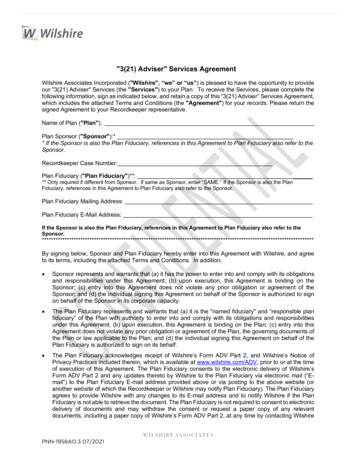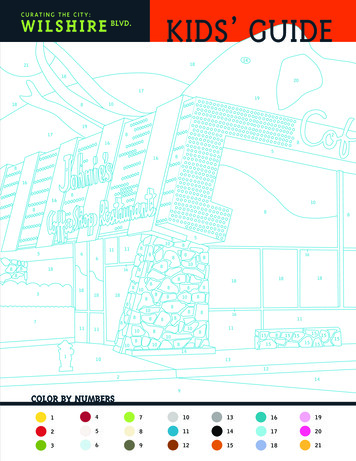
Transcription
CURATING THE CITY:KIDS’ GUIDEWILSHIRE BLVD.252261COLOR BY NUMBERS147101316192581114172036912151821
About the Los Angeles ConservancyThe Los Angeles Conservancy is a private nonprofitmembership organization that works through educationand advocacy to recognize, preserve, and revitalize thehistoric architectural and cultural resources of LosAngeles County. Formed in 1978 as part of the effort tosave the Los Angeles Central Library from demolition,the Conservancy is now the largest local historicpreservation group in the United States, with more than8,000 members. For more information, visitwww.laconservancy.org.Los Angeles Conservancy523 West 6th Street, Suite 826Los Angeles, CA 90014laconservancy.org213 623.2489About This GuideThis Kids’ Guide to Wilshire Boulevard is part of a neweducational initiative of the Los Angeles Conservancy,Curating the City. This program treats the city as aliving museum, presenting a fresh framework for seeingL.A.’s architectural and cultural heritage in new ways.This pilot program encourages you to take anew look at one important aspect of Los Angeles – thegreat Wilshire Boulevard – by touring the boulevardwith this booklet in hand, attending cultural eventsalong the way, and using new resources such as thisguide and a website devoted solely to this project.Visit www.curatingthecity.org to learn aboutthe people, architects, and buildings that made Wilshirethe great boulevard it is today. You can also create yourown customized tour, browse through photo galleries,read personal stories and contribute your own, and findmore educational activities for kids and teachers.
WELCOME TOWILSHIRE BOULEVARD!Many people think of thisstreet as one of the most important inLos Angeles. It’s been called the spine,or backbone, of the city, connectingdifferent parts of Los Angeles. At over100 years old, Wilshire Boulevard haslots of stories to tell about the peopleand the places that have madeLos Angeles famous.Wilshire Boulevard is linedwith office buildings, stores, theaters,churches, apartments, and hotels.You won’t see too many stand-alonehouses, but you will see short and tallbuildings, old and new. As you walkalong the sidewalks, you’ll hear manydifferent languages, from English toSpanish to Korean to Tagalog. WilshireBoulevard is like the rest of Los Angeles– an exciting mix of people from different backgroundsand different parts of the world.But watch out – Wilshire Boulevard can surpriseyou! Don’t just look at a part of Wilshire and think thatyou’ve seen it all. One thing that makes this street soSecurity Pacific Collection / Los Angeles Public Libraryinteresting is that it’s home to a collection of verydifferent neighborhoods. Take some time to exploreWilshire and its incredible buildings. You’ll find thatthe story of Wilshire Boulevard is also the story of howLos Angeles has grown and changed over the years.A VERY LONG LINEWHAT’S A BOULEVARD?Wilshire Boulevard is a pretty long street – almost 16miles. It stretches from downtown Los Angeles all the wayto the Pacific Ocean. The fact that Wilshire is linear, or ina long line, is one of the things that makes it special.Really old cities – like London, Paris, or evenNew York – started with clumps of tiny streets crowdedclosely together. That’s because these cities developedbefore there were cars, when people traveled mostly byfoot or by horse. The small, winding streets were goodfor walking but not for driving.By the time Wilshire Boulevard – and the restof Los Angeles – really started to grow, the car hadbecome an important part of life in Los Angeles. Peopledidn’t want small, winding streets for walking. Instead,they wanted wide, straight roads for driving.Los Angeles was one of the first modern citiespurposely designed with cars in mind. Remember this asyou explore Wilshire Boulevard.The word boulevard is originally from the Germanword for a wall-like structure. The first boulevards inEurope marked the boundaries of cities. Over time,the definition changed to be a wide street with manylanes and beautiful views. Do you think WilshireBoulevard fits this definition?ANCIENT HISTORYThousands of years ago, prehistoric mammoths,mastodons, and saber-toothed cats roamed Ice AgeLos Angeles. A lot of them lived where WilshireBoulevard is now. You can see their bones and learntheir history at the George C. Page Museum at theLa Brea Tar Pits, on Wilshire’s Miracle Mile.1
TAKING IT ALL INThere’s one problem with such a long street. It’s hard to see everything in a day! Use this guide to help you exploreWilshire Boulevard in small pieces. The numbers on this map look backwards, but they’re just listed going east towest, like the descriptions in this guide.21Miles Playhouse1130 Lincoln Blvd.17Beverly Wilshire Hotel9500 Wilshire Blvd.19Westwood &Wilshire Blvds.15May Co. Building6067 Wilshire Blvd.13Dominguez-Wilshire5410 Wilshire Blvd.11The Darkroom5370 Wilshire Blvd.BeverlyBURTON WAUCLAUCLAWILSHIRE TACANIMO17VBLODWOSTWED.E BLVICENTBLSAN V.VDSANDIBUOCEANAVE.CA FONITA MSAND.LVOBCIPY.21DR.FWIWREHISLOSanta Monica.VDLBEGNDYWY.2222Palisades Park220Wadsworth ChapelEisenhower &Bonsall Aves.18Beverly Hilton Hotel9876 Wilshire Blvd.16Johnie’s Coffee Shop6101 Wilshire Blvd.14Petersen AutomotiveMuseum6060 Wilshire Blvd.12Sontag Drug Co.5401 Wilshire Blvd.
Each section will tell you about one of the neighborhoods on Wilshire.Use the buildings in this guide as a starting point to do some exploring of your own.9Scottish Rite MasonicTemple4357 Wilshire Blvd.5Bullocks WilshireBuilding3050 Wilshire Blvd.7St. Basil’s CatholicChurch3611 Wilshire Blvd.Hollywood3MacArthur ParkAlvarado St. toPark View St.1Pegasus731 Wilshire Blvd.GLENDALE FWY.SUNSET BLVD.COMMONWEALTH AVE.SANTA MONICA BLVD.12HIGHLAND AVE.FAIRFAX AVE.Windsor Square/Hancock ParkWilshireCenter10 987HOLLYWADOST.3WILDowntownLos AngelesSHIREBALVAR5FWY.4HOOVER ST.6VERMONT AVE.WESTERN AVE.WILTON PL.11NSHAW13BLVD.14OODParksDistrictWILSHIRE BLVD.CREPICO BLVD.RHA1.Y.FW2ANDBLVD.VENICERBOLVDGRLA CIENEGA BLVD.16 15LA BREA AVE.Miracle MileAVE.HillsAYSANTA MONICA FWY.10Higgins/Verbeck/Hirsch Mansion637 S. Lucerne Blvd.8Wilshire BoulevardTemple3663 Wilshire Blvd.6Ambassador Hotel3400 Wilshire Blvd.4Elks Club/Park Plaza Hotel607 S. Park View St.2Roosevelt Building727 W. 7th St.3
HOW TOLOOKBefore you start your tour, take a look at some of these words. They describe things about buildingsand materials that will help you to see and understand what you’ll explore on Wilshire Boulevard.adapt: to reuse an old building in a new wayarch: a curvedGothic window: a windowwith a pointed arch, patternedafter European styles ofarchitecture used forcathedralsstructure found atan opening, like adoorway orwindowarchitecture: the art and science of buildingstructureslandmark: a placeor a building thatis recognized forits architectural,historical, and/orculturalimportancecolumns: the tall, straight “legs”that hold up or decorate abuilding, usually in the frontAnne LaskeyTom Owen Collection / LAC Archivesfaçade: the outside face of a building, usually the frontfrieze: a sculpturedor highly decoratedband, or wide line4marble: a stone that oftenhas multi-colored patternsand thin, branching linescalled veins; it can bepolished and used forbuildings and sculpturespreservation: saving and reviving buildings, sites, andneighborhoods that are important to our historyand culture
Tom Zimmerman PhotographyRomanesquewindow:a window with arounded arch,patterned afterancient Romanstyles of architectureAnne Laskeysetback: a series ofraised levels on abuilding, with each oneset back from the other,resembling stepsstreaming lines:parallel lines ingroupsterrazzo: a type of floor design made of coloredmarble chips set in a mixture of sand, plaster, orcement, then ground and polished to be smoothand shinyARE YOU REALLY LOOKING?Sometimes we walk down the street without really seeing what’s right in front of us.On this tour, pretend you’re a detective.At each building, look closely for the important details that make it special.Try this checklist to help you make the most of your visit.1. Observe.o What does the building look like?o What colors does it have?o What materials is it made of?o What details make this building different orspecial?2. Compare.o How is this building like other buildings thatyou’ve seen before?o How is it different?3. Ask a Question.o How do people use this building every day?o How can you tell the purpose of the building fromthe way it looks?o Why do you think the architect made the buildinglook this way?o How has this building changed since it was built?4. Make a Good Guess.o Use what you’ve observed and what you alreadyknow to come up with some possible answers toyour questions.5. Form an Opinion.o Do you like this building? Why or why not?o What do you like about it?o What would you change?o What would we be missing if this building weregone?Now you’ve got all the toolsyou need. Let’s explore!5
DOWNTOWNWilshire Boulevard wasn’t always WilshireBoulevard. In the very beginning, this part of Wilshirewas called Orange Street. Over time, city plannersconnected other streets and widened them into theboulevard that you see today.Downtown is a good place to start exploringWilshire. In the early days of Los Angeles, this is whereHi! My family (we’re Ancient Bison)migrated through here a long time ago.you’d find most of the action. All of Los Angeles’ officebuildings and big department stores were here. Overtime, Los Angeles spread westward toward the ocean –and so did Wilshire Boulevard.While this is one of the oldest parts of L.A.,some of the most modern buildings on our tour are righthere. Take a look.1 THE PEGASUS 731 Wilshire Blvd.Anne Laskeyexample of how people can adapt, or reuse, oldbuildings in new ways.There are a lot of details that make the Pegasusspecial. Check out the cube-shaped blocks, the hard,smooth base, and the grand entrance. Like manymodern buildings, the Pegasus has alot of horizontal and vertical lines.Look at how the metal columnsstretch up into the sky and how thewindows stretch around the buildinglike a horizontal band. Did younotice that the windows fold likeaccordions?WHAT’S IN A NAME?Security Pacific Collection / Los Angeles Public LibraryYou’ll have to stand across the street to get a reallygood look at this building and to be able to see a fewothers nearby. Can you guess what this building is usedfor? If you guessed that it’s an office building, you’reright – sort of. Back in 1949, the General PetroleumCompany built this structure for theirmain headquarters. In those days, itwas the largest office building inSouthern California! It was later usedas Mobil Oil headquarters. Today,this building has a new name and anew use. It’s called the Pegasus, andall those offices have been convertedto apartments. The Pegasus is a greatThe Pegasus was a winged horsefrom ancient Greek and Romanmythology. The Mobil OilCompany used a drawing of thePegasus as their logo for manyyears. When the Mobil officeswere adapted to apartments, thenew owners thought it would bea great idea to name the buildingafter the Mobil logo.
The Pegasus is a good example of what iscalled modern architecture. So what is modernarchitecture? Maybe you can figure it out bycomparing it to something that’s not modern.Take a look at the Roosevelt Buildingat Seventh and Flower, built in 1923. Observethe details closely and compare them with thePegasus below. Then try to come up with yourown definition of “modern” architecture! Bruce BoehnerStand here to seeboth buildings atthe same timexPegasusWILSHIREFLOWER STREETWHAT’S MODERN?RooseveltBuilding7TH STREETPegasus2 Roosevelt Building 727 W. Seventh St.Describe thebuilding’s “blocks”: What’s their shape? What’s their color? Are they rough or smooth?Describe the building’s: entryways decoration materials used overall “feel”My definition of modern architecture:WELTON BECKET AND ASSOCIATESArchitects like Welton Becket helped come up with a brand new look forbuildings in the years after World War II, when business boomed and a lotof construction was taking place in Los Angeles. He and his partnerWalter Wurdeman designed the General Petroleum building (now Pegasus).They created buildings that were very strong but looked light rather thanheavy. You can find many buildings by Becket in Los Angeles, including morethan 20 on Wilshire Boulevard alone.Herald-Examiner Collection / Los Angeles Public Library
THEPARKS DISTRICTWith its green grass, playgrounds, and lake,MacArthur Park is quite a change from downtown! In theold days, this was Westlake Park – the city changed itsname during World War II to honor Army GeneralDouglas MacArthur. The neighborhood is still called theWestlake district.The park’s name might have changed, but otherthings have stayed the same over the years. People stilluse this park every day for exercise, for play, and formeeting friends. Sunset (now Lafayette) Park nearby isanother historic gathering place.3 MACARTHUR PARKTake a look at this picture ofWestlake Park a hundred yearsago. Observe closely and takesome notes. How did people usethe park long ago? How do weuse the park today? J. Eric Lynxwiler CollectionWilshire Blvd. betweenAlvarado & Park View Sts.Westlake Park, early 1900sMacArthur Park todayHENRY GAYLORD WILSHIRE8You might be wondering how thisboulevard got its name. Henry GaylordWilshire came to California from Ohio in the1880s. One of the first things he did was tobuy a large piece of land near a swampthat had been recently transformed intoWestlake Park. In 1895, he built a widestreet through the property and named itafter himself. At first, his boulevard onlywent between Westlake (now MacArthur)Park and Sunset (now Lafayette) Park a fewblocks away. But over the next thirty-nineyears, it stretched west toward the oceanand eventually connected with otherstreets that were stretching east intodowntown. The whole long boulevard gotMr. Wilshire’s name.Security Pacific Collection / Los Angeles Public Library
CUTTING THE PARK IN TWOWestlake (now MacArthur) Park was a beautiful greenspace that many Angelenos loved. There was only oneproblem: it blocked Wilshire Boulevard from stretchingfrom downtown to the ocean in one unbroken line. In1934, the city of Los Angeles decided to cut Westlake Parkin two by adding a new strip of Wilshire. By dividing thepark, the city could create a long, more direct straightstreet (called a thoroughfare) that would be better forcars. Traffic would be smoother because peoplewouldn’t have to drive all the way around the park. Do you think the city did the right thing individing the park? Make a list of the benefitsand disadvantages.BenefitsDisadvantages4 THE ELKS CLUB/PARK PLAZAHOTEL\607 S. Park View St.(between Wilshire Blvd.& Sixth St.)Check out the elk over the entranceway – it’s animportant clue to this building! When this structureopened in 1925, it was a gathering space for a men’s clubcalled the Benevolent and Protective Order of Elks. TheElks got together for fun as well as to plan charityprojects to help people in need.Look at the statues on the front of the building.They show some figures that look like they could befrom ancient cultures. Others are dressed in militaryuniforms from the early twentieth century.Choose three of the characters you like best,and sketch each one below. Then make a guess:what do you think each figure represents?Exterior & detail: Tom Zimmerman PhotographyAnne Laskey
WILSHIRE CENTERSecurity Pacific Collection / Los Angeles Public LibraryTry to imagine a dirt road andfields of beans and barley. That wasWilshire Center in the early 1900s. Fewpeople back then could imagine whatit looks like today!What changed everything?The automobile! Once people hadcars, they could travel more quicklyand easily than ever before.Businesses didn’t need to stay in theovercrowded downtown areas. Theycould spread out. But how couldbusinesses attract customers to the“countryside” of Wilshire Center?The corner of Wilshire and Western Ave. in1931. It was once the busiest corner in the U.S.!5 BULLOCKS WILSHIRE/SOUTHWESTERN LAW SCHOOL3050 Wilshire Blvd.10Anne LaskeyIn 1929, a newdepartment store calledBullocks opened inWilshire Center. It wasway out in the suburbsthen, and was the firstdepartment store builtwith cars in mind. Itsstunning design featured terra cotta and copper, and a240-foot tower.How did the owners of Bullocks make customerswant to drive all the way out to their store to shop?They gave them parking! They also built really big newwindows along the front of the store, so that peopledriving by could see what was inside. That may notsound like a big deal to you, but it was a brand newidea back in the 1920s.Today, this building is the jewel of the Southwestern LawSchool campus. That’s a great reuse of a historic space.Southwestern spent a lot of time and money fixing thebuilding up so that it could work as a school. But theyalso worked hard to keep the beautiful, original detailsof the building.
WORSHIP ON WILSHIRELAC ArchivesWilshire Boulevard is a street full of churches, temples,and other sacred spaces. Just as Los Angeles is a mix ofpeople from many different backgrounds, Wilshire hasplaces of worship for many different faiths. At someof the churches in this area, there are as many as fivelanguages spoken – English, Ethiopian, Korean, Spanish,and Tagalog!6 THE AMBASSADOR HOTELAnne Laskey7 ST. BASIL’SCATHOLICCHURCH3611 Wilshire Blvd.This church was built in1969 to replace an olderwooden church that lookedvery different. Its architectschose to use modernmaterials, like concrete, with steel and stained-glasssculptural towers on the outside.8 WILSHIRE BOULEVARD TEMPLE Laszlo Regos Photography3663 Wilshire Blvd.This Jewish temple wasbuilt in 1929. Many of itsfeatures reflect ancientarchitecture, like theRomanesque doors andenormous dome.3400 Wilshire Blvd.The Ambassador used to be the fanciest hotel in LosAngeles. Everyone stayed here: presidents, movie stars,even kings and queens. You could move in and neverleave – it was like its own little city, with a post office,travel agency, restaurant, and hair salon!Like Bullocks, the Ambassador was specialbecause of its location. It was an easy spot for drivers toget to in their cars, and the hotel looked very impressivefrom the boulevard. Soon, many hotels sprang up alongWilshire, hoping to be as successful as the Ambassador.The hotel closed in 1989. Groups like the LosAngeles Conservancy worked hard for almost 20 years tosave this important landmark from being torn down.When the school district bought the property in 2001,the Conservancy and lots of volunteer architects andreal-estate people figured out how to use the main hotelbuilding as part of a terrific new school campus.Unfortunately, the hotel’s demolition was approved in2005 to make way for all-new school buildings. Justthink how great it would have been to go to school inthe same place where world leaders and movie starsonce stayed.Take a closer look at these two places of worship. See if you can find some of their similarities and differences. St. Basil’s Catholic ChurchWilshire Boulevard TempleMaterialsColorsWindowsThe highest point of the buildingClues that tell youit’s a place of worship11
WINDSOR SQUARE / HANCOCK PARKSo far, you’ve seen spots on Wilshire wherepeople have worked (like downtown), played (like thepark), shopped, and worshipped (like Wilshire Center).Wilshire Boulevard is also a place where people live.In the early 1900s, many parts of Wilshire werefull of huge mansions, or large, impressive houses.Wilshire Boulevard was the fashionable address to have.But as more businesses popped up on Wilshire, peoplemoved to different neighborhoods – and so did theirhouses! Some wealthy people actually put their homes onlarge trucks and moved them to new spots in HancockPark and Beverly Hills.In 2005, the residents of Windsor Square hadtheir neighborhood declared a historic district, known inLos Angeles as a Historic Preservation Overlay Zone(HPOZ). HPOZs help keep historic neighborhoods fromchanging too much, so that you can enjoy them for yearsto come – and so can your own children someday!10 HOME SWEET HOMEPAUL REVERE WILLIAMSLAC ArchivesPaul Revere Williams was a popular architect whodesigned over 2,000 houses and other buildingsduring his long career, which started around the1920s and 1930s. He designed many of thebeautiful homes in Hancock Park, and hisarchitectural office wason Wilshire Boulevard.He is among the mostimportant architectswho worked in L.A., andthe first AfricanAmerican to join theAmerican Institute ofArchitects.Why do you think the house has three names?637 S. Lucerne Blvd.(between Wilshire Blvd. & Sixth St.)Larry UnderhillANSWER: It is named for the three owners of thehouse over time; the Hirsch family lives there now.12Imagine waking up every morning in thisbeautiful house! This is the Higgins/Verbeck/Hirsch Mansion, and you can find it just half ablock off of Wilshire. This neighborhood is calledWindsor Square, where you can find lots of homesfrom the early 1900s to the 1920s. As Wilshiregrew, this became a popular residential area, or aplace for people to live.This style of architecture is calledVictorian. It’s named for the time period whenQueen Victoria ruled England, from 1837 to 1901.Like many Victorian homes, this house is made ofwood. It has a big front porch and large windowsto let in a lot of light. At first, this house stooddown the street near Bullocks Wilshire, but in 1924Howard Verbeck moved it to its current spot.Builders cut it into three parts for the move, andMr. Verbeck held a party in one of the parts as itrolled down the street. Even the mayor was there!
9 SCOTTISH RITEMASONIC TEMPLE4357 Wilshire Blvd.Like the Elks Club downtown, the ScottishRite Masonic Temple is a place for peopleto come together. Millard Sheets designedthis building in 1961 for the Masons, amen’s society.It is located on an interestingcorner. Across the street are two otherimportant meeting places: the WilshireUnited Methodist Church and the Ebell ofLos Angeles, which was once the country’slargest women’s club.Who are the Masons? Hundreds ofyears ago, stoneworkers, or masons, joined together asa group. They helped each other find work and taughteach other the skills of their trade. Today, you don’thave to work with stone to become a Mason. Mostly,Masons meet for fun and help others in need. Butthey’ve kept many of their ancient traditions.Larry UnderhillSome Mason traditions and symbols are still secret andmysterious. Make your own guesses below about whatthe symbols on the façade (face) of the temple mean. The symbols include:JOIN the CLUB!A clubhouse is a placewhere people who havethings in common (a socialcause, a craft, etc.) canmeet. If you were to designa clubhouse, what wouldit look like? Draw thesymbols or decorations youwould use.13
I’m a saber-toothed CAT (not tiger).We are extinct and our fossils are theofficial state fossils of California.MIRACLE MILEWhat made Miracle Mile a miracle? Here’s thestory. During the 1920s, a man named A. W. Ross boughta bunch of land on Wilshire. He planned to build storesand other places where people would come spend theirmoney. Some people thought he was crazy. Who wouldwant to travel so far just for shopping? They called hisproperty on Wilshire “Ross’ Folly.” (A folly is a ridiculousmistake.) But they were wrong, and Ross was right.Shoppers did come, stores made money, and suddenly,Ross’ Folly became “Miracle Mile.”Miracle Mile is a very special section of Wilshire.Here, you’ll find an exciting collection of buildings in arange of architectural styles. How do you know what tolook for? Here are a few pointers.Larry UnderhillART DECOSTREAMLINE MODERNEArt Deco buildings were very popular in the1920s, when people had a lot of money tospend on buildings with extra decoration andexpensive materials. Here are a few detailsthat can help you identify an Art Decobuilding:The Streamline Moderne style became popular during theGreat Depression of the 1930s. This was a time when peopledesigned simpler buildings with less expensive materials butstill made them look beautiful. Here’s what you might see in aStreamline Moderne building:you-are-here.com more horizontal linesthan vertical lines, withbuildings appearing to“hug” the ground zigzag shapes withjagged lines horizontal bands ofwindows vertical lines todraw your eyeupward to the sky setbacks (when theupper levels areshaped like thesteps on astaircase) designs withimages fromnature, like leavesand vinesAnne Laskey streaming linesPhoto by Julius Shulman, J. Paul Getty Trust, The Getty Research Institute curved corners or rounded windows
Security Pacific Collection / Los Angeles Public LibrarySecurity Pacific Collection / Los Angeles Public Library 13 DOMINGUEZ-WILSHIREBUILDING 5410 Wilshire Blvd.12 SONTAG DRUG CO. BUILDING5401 Wilshire Blvd.What do you think is the style of this building?What do you think is the style of this building?What “clues” did you use?What “clues” did you use?11 THE DARKROOM 5370 Wilshire Blvd.Tim Street-PorterWith a name like “The Darkroom,” can you guess whatthis store sold? Take a look at the front of the store, andit’s a dead giveaway! This building is from 1926, but in1938 the owners redesigned the front of the store to looklike a camera,down to all theknobs andbuttons. A fundesign like thiswas a sure wayto get those cardriving shoppersto pull over for asecond look!Try designing your own store so that its exteriorlooks like the product it sells. What would acandy store look like? How about a hot dog stand?15
MORE OFMIRACLE MILE15 THE MAY COMPANYBUILDINGTim Street-Porter6067 Wilshire Blvd.When this was built in 1939, everyone agreed thatit was beautiful. With smooth, horizontal lines,curved edges, and bands of windows, it was anexciting example of Streamline Moderne architecture. The May Company was a fancy departmentstore – and the gold cylinder on the building’scorner looked a lot like a perfume bottle!The department store closed its doorsin 1993. The building’s owner planned to tear itdown and build office towers and a hotel.But preservation organizations, such as theLos Angeles Conservancy, fought to save it.They worked with county officials to make sure itwould be reused instead of torn down. Today,this building is being reused as part of theLos Angeles County Museum of Art.BEFORE14 THE PETERSENAUTOMOTIVE MUSEUM6060 Wilshire Blvd.What could be more perfect than amuseum for cars on a street wheredriving is the name of the game? Thismuseum is another great example of howan old building can be reused. Originally,this was the Seibu Department Store, astore that sold special products fromJapan. Then, it was Ohrbach’s DepartmentStore. In 1994, the Petersen AutomotiveMuseum took over the space. Architectsmade some changes before the carsmoved in.Anne LaskeyTake a look at the “before” and “after” pictures. Can you identify what’s different? Use the picture of thecar as a clue. Why did the architects make these changes? Write your ideas below. 16ANSWER: The changes give the building elements thatlook like the “fins” on an old car or car wash.
16 BLAST OFF TO JOHNIE’S!you-are-here.com6101 Wilshire Blvd.This coffee shop openedin 1955, when Americanswere interested in spacetravel and anythinghaving to do with thefuture. This futuristic styleof architecture is called“Googie” architecture.The unusualname comesfrom acoffee shop named “Googie’s” that used tobe on Sunset Boulevard and that wasdesigned in a similar style.You can find all kinds of coffeeshops, motels, and bowling alleys fromthe 1950s that were designed in this way.At Johnie’s, look for the upwardsloping, butterfly-shaped roof – it makes thebuilding look like it’s hanging from the sky!ADAPT IT! Johnie’s is no longer used as a coffee shop. (It ismostly used for filming movies.) Come up withyour own idea for how to adapt, or reuse, thisbuilding. Be sure to think of a creative way tokeep and use the big windows and cool sign!AFTERCourtesy Petersen Automotive Museumyou-are-here.com17
BEVERLY HILLS17 Beverly Wilshire Hotel9500 Wilshire Blvd.18 Beverly Hilton Hotel9876 Wilshire Blvd.This stretch of Wilshire isworld-famous as a ritzy shoppingdistrict. Would you believe thatbefore these stores and hotels werehere, this land was used for a carracetrack?! Today, you can findsome very glamorous hotels in thisneighborhood.B. Doggett 2005 The Beverly HiltonTake a good look at the Beverly Wilshire Hotel and the Beverly Hilton.How is one different from the other? Use the chart below to compare them. Does it look old or new?What shapes and textures do you see?What details make thisbuilding special or different?What do you like about each?Herald-Examiner Collection / Los Angeles Public Library18Can you believe there used tobe a racetrack in Beverly Hills?This photo was taken at thetrack in 1921.
WESTWOODI root for the UCLA Bruins, althoughI wish they had named their teamafter me, a Shasta Ground Sloth.19 Westwood is a little bit like a college townStop at the corner of Wilshire and WestwoodBoulevards. How is your view different from what yousee in this photograph from the 1930s? How do themany high-rise buildings in this area compare to theother parts of Wilshire that you’ve seen so far? Security Pacific Collection / Los Angeles Public Librarywithin a big city – it’s home to the University ofCalifornia, Los Angeles. One thing that makes this partof Wilshire special is the huge number of high-risetowers that you see as you travel down the boulevard.VETERANS AFFAIRSThere are big plans underway to restore,or fix up, Wadsworth Chapel. Take a goodlook at it yourself, from the bricks at thebase of the building to the paint job onthe exterior. If you were in charge of therestoration, what steps would you taketo fix up this structure
WILSHIRE BLVD. W IL S H R E B L V D . W I L S H I R E B L V D. W I L S H I R E B V D. Westwood 15 May Co. Building 6067 Wilshire Blvd. 19 Westwood & Wilshire Blvds. 17 Beverly Wilshire Hotel 9500 Wilshire Blvd. 11 The Darkroom 5370 Wilshire Blvd. 13 Dominguez-Wilshire 5410 Wilshire Blvd. 22 Palisades Park 21 Miles Playhouse 1130 Lincoln Blvd .


